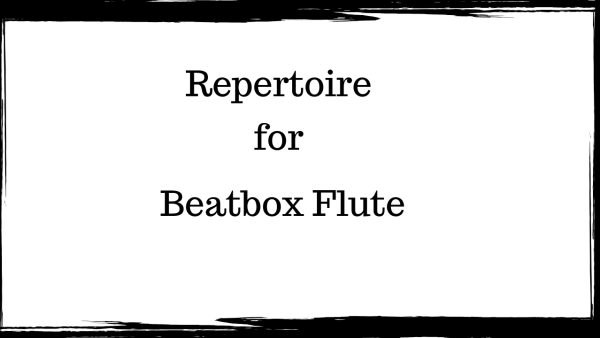The Bass Flute ~ Expressing the secrets from deep within the human soul ~
The bass flute is a relatively young instrument that designers started experimenting with during the 1920s and 30s. Because there were different makers all working towards ‘inventing’ the instrument scattered across various parts of the world there are a number of different versions of the instrument. The most popular/successful design came from the Brittish Rudall, Carte and Company. Today this is considered the standard and looks very similar to a concert flute. It is held out to the side and the pipe bends around in a U shape to allow the performers to reach the keys. It is exactly twice the size of a regular concert flute with an approx. length of 146 cm or 57 in.
Around the same time as Rudel Carte, Abelardo Albisi, an Italian flute player was developing an upright bass with a B footjoint. This design took longer to evolve into a working instrument. However today Kotato and Fukushima, Jupiter and Kingsma all produce upright basses.
Up until the 1920s, the alto flute was frequently referred to as a bass flute simply because it had been the lowest member of the flute family. After the invention of the bass flute, the ‘original’ bass flute became formally known as an alto flute.
Originally the bass flute was mostly used in flute ensembles. However, there is now a growing amount a solo, chamber and orchestral music being composed for the instrument.
The bass flute is played in exactly the same way as a regular flute with the flautist blowing across the embouchure hole to produce a sound. The instrument uses a lot of air that moves very slowly especially when compared to the piccolo which uses very fast air. Typically a bass flute has closed holes and a C footjoint however there are models with a B footjoint.
Despite the size of the instrument it is surprisingly responsive and has maintained a lot of the agility associated with the flute. However, sometimes when the instrument is exceptionally cold it will be rather slow to respond.
The bass flute is naturally quieter than a normal flute and is consequently often amplified during performances. (see how to amplify a bass flute).
Another dilemma facing both makers and flautist was the weight of the instrument. Horizontal bass flutes must be supported by the flautist. Consequently, flautists need to be gradually build up their arm and finger muscles so they can support the instrument. There are lap crouches that can help take the weight of the instrument but these are often quite awkward to use. In comparison, the vertical or upright bass is supported by a cello spike so the floor takes the majority of the weight.
The bass flute is a transposing instrument with its sounding pitch being one octave lower than it is written.
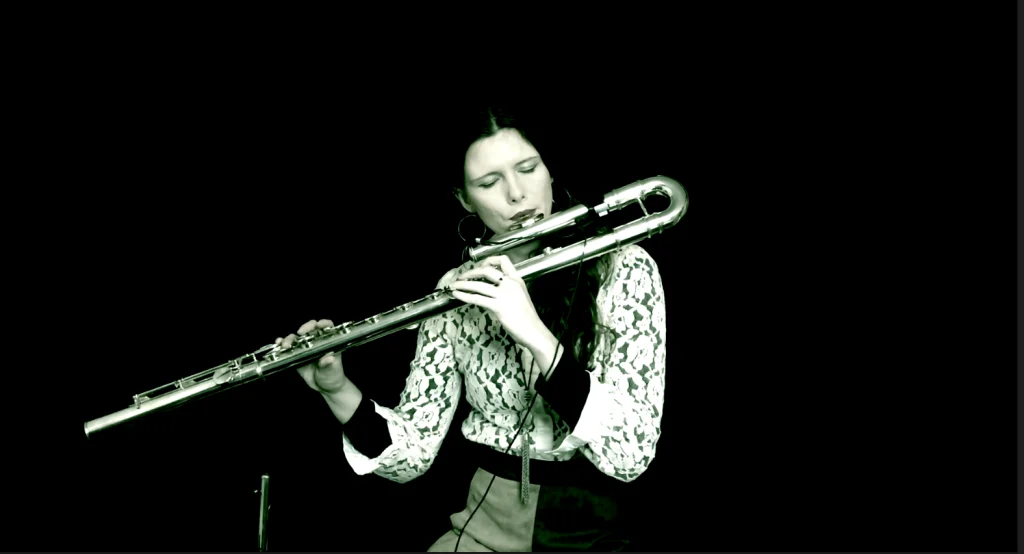
The Experts
Bass Flute Written Range
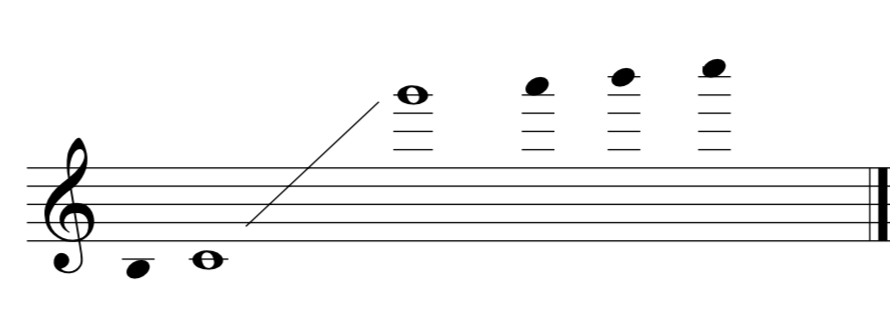
Bass Flute Sounding Range

Bass Flute Variations
Up Right Bass
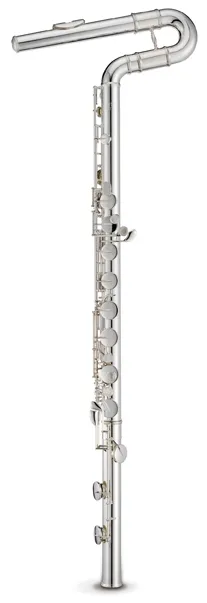
The upright bass is very similar to its horizontal twin accept it has been shaped to support a vertical playing position. The height of the instrument is adjusted to suit the player using a small cello spike that is attached to the bottom end of the instrument. All the fingering is the same. The instrument is positioned like a bass clarinet in front of the performer.
Kingma Open Holed Bass
The Kingma System allows both alto and bass flutes to be made with open holes. Their bass flute models are available as either a vertical or horizontal instrument. One of the key advantages to open holes is they provide the player with greater control over the instrument. They also allow the instrument to play a variety of extended technics such as glissandi and multiphonics that would otherwise be impossible to produce. (Learn More)

Seven Bass
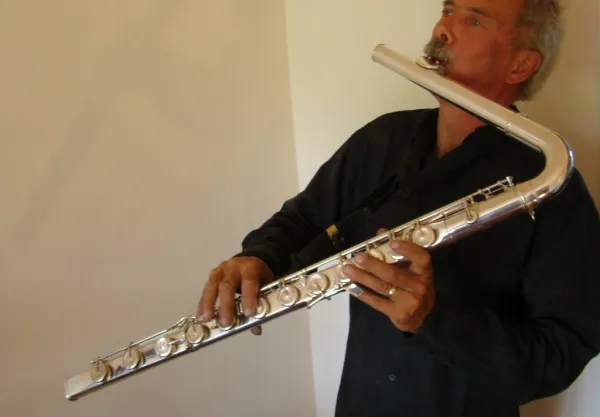
The Seven Bass Flute by Hogenhius is essentially the same as the Epsilon except is it shaped like a number 7. The reasoning for this is to achieve a more ergonomic hand positioning. This type of bass flute are exceptionally rare and are only made by Hogenhius. (Learn More)
Epsilon Bass
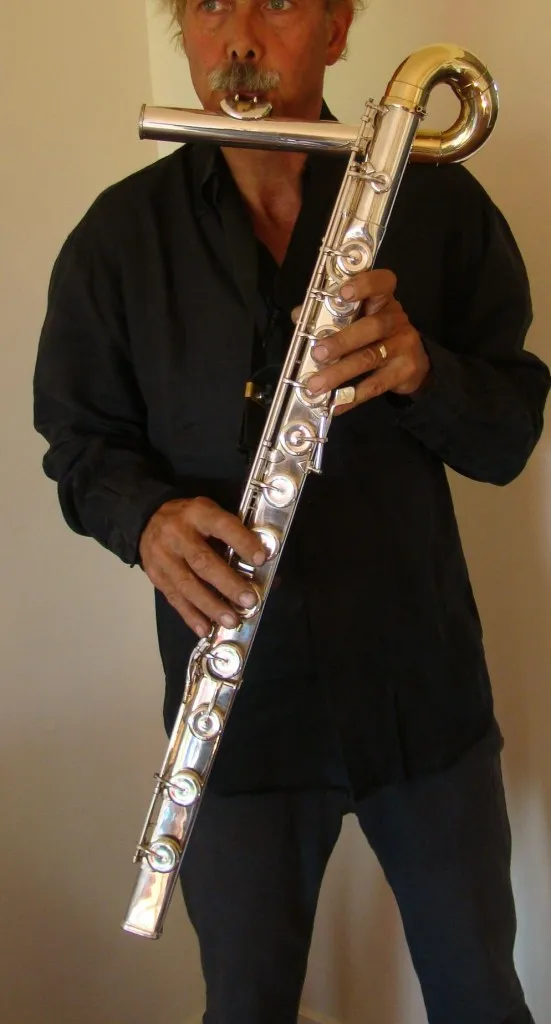
The Epsilon bass flute by Hogenhius is unique in its design. The weight of the instrument is support by a strap that goes around the performer’s neck and then clips onto the instrument. Much like a saxophone. This help performers to play for longer before experience fatigue.
Instead of the tube of the instrument being cylindrical it is a semi-circle with the keys attached to the flat service. This instrument has been designed specifically to increase the volume of the instrument. It also increases the clarity of its bottom register allowing notes to be produced with a very clean attack. (Learn More)
Bass Flute in F

Kotato and Fukushima produce an instrument that they call bass flute in F. It goes a fourth lower than a standard bass flute and really is more of a contra-alto flute than a bass flute. (Learn More)
Old Bass Flutes
The bass flute went through many different developmental phases. Some of these included an upright bass flute with an “S” shaped bend in the neck. Another one by Rudel Carte was a horizontal version with an “S” bend. The double bend in these instruments would have had interfered with the intonation of the instrument. It also would have been very challenging to clean.
Rudall Carte & Co. Vertical Bass Flute in C

The Epsilon bass flute by Hogenhius is unique in its design. The weight of the instrument is support by a strap that goes around the performer’s neck and then clips onto the instrument. Much like a saxophone. This help performers to play for longer before experience fatigue.
Instead of the tube of the instrument being cylindrical it is a semi-circle with the keys attached to the flat service. This instrument has been designed specifically to increase the volume of the instrument. It also increases the clarity of its bottom register allowing notes to be produced with a very clean attack. (Learn More)
Albisiphon in C

Rudall Carte & Co. Horizontal Bass Flute in C

Meet the Bass Flute Specialists
Chris Potter
Chris Potter is an American flautist who specialises in alto and bass flute. She has an impressive CV and has commissioned and premiered many new works for alto and bass flute. Chris has completed a doctorate in flute performance, performed around the world and written/arranged 15 books. She also runs a yearly alto and bass flute retreats and offers alto/bass flute lesson over Skype so students from around the world can benefit from her wealth of knowledge and experience.
Peter Sheridan
Peter Sheridan is a performer, teacher, instrument inventor and mentor to The Techie Flutist. He is a huge supporter of new music and has commissioned countless works for low flutes. Peter specialises not only in alto flute but also in the bass, contra, sub-contra, and hyper-bass Flutes. He is currently working to develop a sub-hyper-bass flute which will reach beyond the lowest notes of the piano. Peter is an inspirational teacher whose contribution to the global low flutes community cannot be overlooked.
Starting to Play the Bass Flute
It is recommended that students first start leaning flute on a standard concert flute. Once a student has grasped the basics of sound production and fingering, and are physically big enough to support a larger instrument they may move across to the bass flute at any time.
Air and Embouchure
The bass flute obviously uses vastly more air than a traditional concert flute. However, it is more air moving at a much slower speed. This takes time to get used to and you will need to have an open and relaxed embouchure.
The Strongest Register
On a standard concert flute, the lower register of the instrument traditionally soft and mellow while the middle and upper registers can be quite strong and loud. The bass flute, however, is not like this as its lower register is its strongest. The middle to upper registers, while weaker, have a beautiful and delicate sound. They require very precise air direction and speed and are easily overblown. It takes time and patience to learn to play these notes consistently with a diverse dynamic range and good intonation.
Intonation
The larger the flute the harder it is to keep in tune especially at the lower and upper ends of its range. To help you become accustomed to the instrument I recommend creating yourself a flute map.
- Grab a blank piece of paper and create a three-column table
- Running down the left-hand column write every single note from the flute range from the bottom to the top. Don’t forget to include all the sharps and flats.
- In the middle column mark down the natural tendencies of your pitch for every note. I usually include the labels: Very Flat, Flat, Unstable, Stable/good, sharp, very sharp. Use an electronic tuner to help you accomplish this. (Available here)
- Do the same thing in the third column but this time with your bass flute.
By doing this you can visually see how the bass flute differs to your concert flute and you will be able to start learning the areas where you need to either lower or raise your pitch. Note that sometimes alternative fingering can be used to help improve your pitch but the one that works best will change from instrument to instrument.
This will also help you to become familiar with the instruments ‘fluffy’ or ‘weaker’ notes. For example, the second octave Eb is notoriously ‘fluffy’.
Starting Points
- Long Tones – starting on A or B walk all the way down your instrument one note at a time. And then all the way back up. Aim for a clean, big and consistent tone.
- Octaves – it is very common to overshoot when you are playing in the middle and upper registers and accidentally land on one of the harmonics. Octaves will help you to learn the exact airspeed and angle required for each note.
- Simple Melodies – Use simple melodies to explore the expressive capabilities of the instrument. Dive into dynamics and tone colours and don’t forget to start experimenting with your breathing and how you want to shape the phrases.
- Finger Technique – everything is harder on the bass flute including co-ordinating your fingers. Explore a variety of scales or fingering patterns and really get a feel for how much effort it does and doesn’t take and how fast and even you can get things happening.
Bass Flute Accessories
Stand
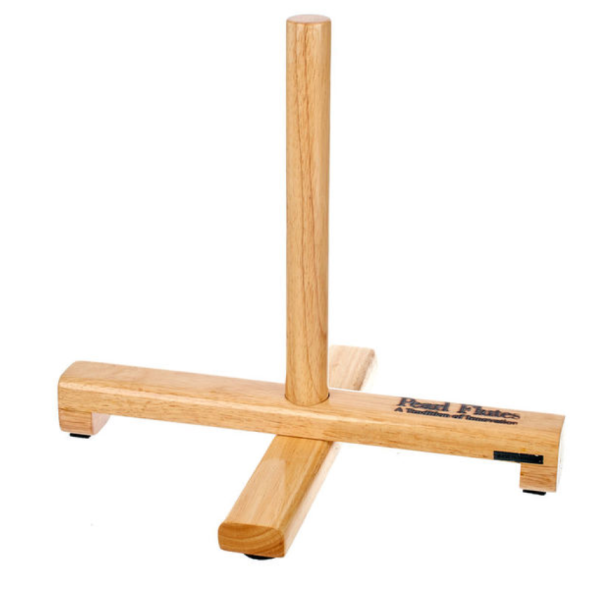
A bass flute stand allows you to easily put the instrument down without putting any
pressure on the keys. They are perfect for when you need to swop between different flutes for a gig. There are a number of different ones on the market. This particular one is made by Pearl and comes apart for easy transport.
Bass Boost
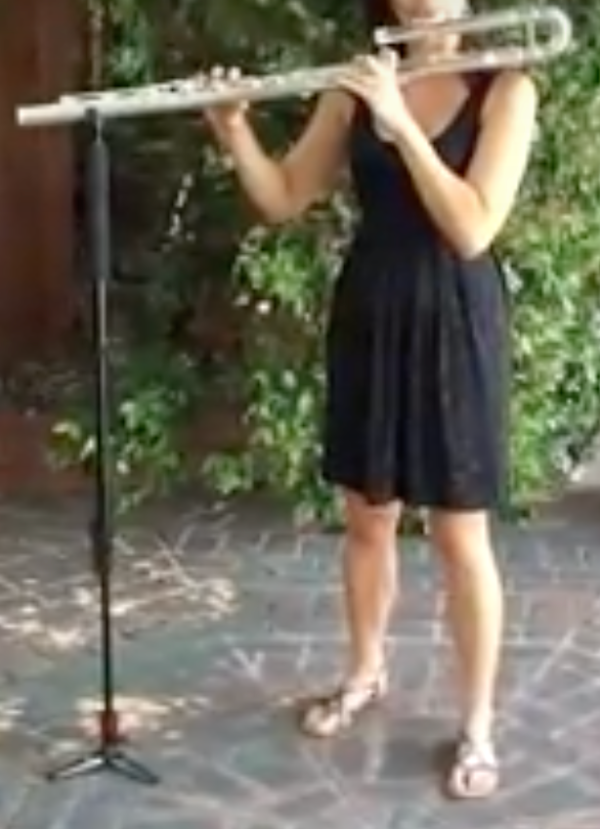
The Bass boost has been designed to hold the weight of both alto and bass flutes. Its height is fully adjustable and it can be used in both sitting and standing positions. Because this is a specialised product it is on the expensive side.
A cheaper but less aesthetically pleasing alternative is to use a Manhasset music stand with the top flipped upsidedown and a blanket/jacket/scarf covering it. The fabric is simple so that your instrument doesn’t get scratched. This option also only works if you are sitting down.
Lap Crutch

The idea behind the lap crutch is good. However, I personally have found them to be more trouble than they are worth. The idea is that you adjust the crutch to be the correct height for your body. Next, you place one end on your lap and then your flute rests on the other end. It is usually positioned under the F key. The problem is that the second you move your instrument ever so slightly the crutch drops to the floor with a loud bang. But it does help to take a lot of pressure off your right hand.
The Bass Flute Method Book
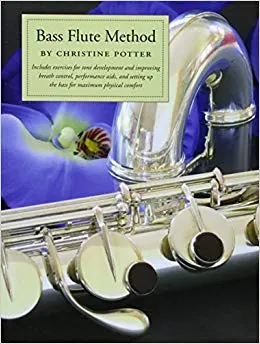
A bass flute stand allows you to easily put the instrument down without putting any
pressure on the keys. They are perfect for when you need to swop between different flutes for a gig. There are a number of different ones on the market. This particular one is made by Pearl and comes apart for easy transport.
Keep in mind that we may receive commissions when you click our links and make purchases. However, this does not impact our reviews and comparisons. We try our best to keep things fair and balanced, in order to help you make the best choice for you.
Other Resources
Chris Potter Resources
Kingma Bass Flute System
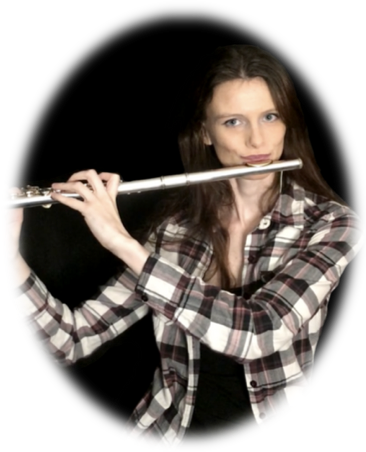
Learn Flute, Learn Beatboxing
The Techie Flutist welcomes students of all ages, abilities and styles to the wondering of flute lessons.
- Develop Instrumental and Artistic Excellence
- Learn to reconnect with yourself and express your emotions
- Develop your creativity and critical thinking skills
- Friendly personalised environment
- Every style and genre
- Flexible Lesson Times




